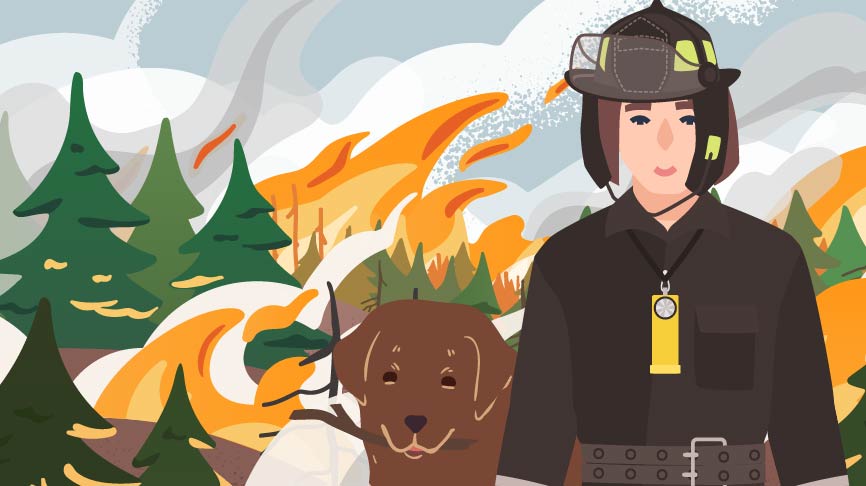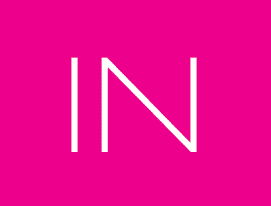Periods & Pandemics: Interview with a Crisis Response Officer

Nika’s inspiring professional role includes civil protection, volunteer firefighting, and training rescue dogs, so I’ve invited her to talk openly about her essential work and managing her period in times of crisis.
DON’T GIVE UP THE CUP
I’ve never tried a menstrual cup until a month ago. It reminded me of putting a tampon in for the first time. I bled a little over it, decided it is weird, and swore I shouldn’t do it again too soon. Not many warn you of the uncomfortable feeling of the first use, and how there’ll always be an emotional barrier before finding your own comfortable spot.
Which is why I’d probably give up the cup if it wasn’t for two reasons. First, I’m locked inside for more than a month and it is easier to test a new period solution within your four walls. And second, I have a childhood friend who is a preacher of menstrual cups and all in all, an impressive personality.
We all know for which reasons we are locked up inside around the globe, so I do not want to spend a lot of time commenting on a coronavirus situation.
I hope people respect social distancing rules and that we find a way to stabilize the critical situation. I want to talk to you more about menstrual cups, and my amazing friend, who also does an important job in civil protection during this crisis, all #whilebleeding.
Hi Nika, can you tell me what you do?
Nika: I work in civil protection and also train rescue dogs. I’m a crisis management graduate and also work as a volunteer firefighter. All my work has to do with responding to emergencies. Currently, our job as civil protection is to distribute medical supplies to hospitals when masks and protective gear arrive on airplanes from other countries.
THE TIPPING POINT
How did you decide to start using menstrual cups?
Nika: I have done some research on my own. I was looking for a better solution than tampons and pads. Something that I can count on when I am on the move and away from stores. At the time they were not as easily accessible and it took me some time to even find a way to get one.
Can you think of an inconvenient situation when you got your period?
Nika: Once we were in Cyprus, at a training seminar. It was a part of an international community and a platform of EU countries that provide aid in response to emergencies. For example, Croatia asked for tents and other equipment for forming emergency camping grounds after the recent earthquake alongside all the protection gear for the pandemics. As a response, our neighboring countries offered the equipment and in a matter of hours, it was on our way. It’s a platform where countries ask for help and other countries offer what they can. It is like an emergency charity marketplace. Another example where we were directly involved was when Albania asked for dog search & rescue teams after the earthquake where my dog and I went as well.
But to go back to Cyprus, that was my tipping point. After highly intense training seminars, my flight was unexpectedly delayed for a day and they put me in a hotel. And that’s when I got my period – in the evening, exhausted, in a foreign country. That’s the time I definitely decided I need to plan more with my period, so I’ve done some research independently and decided to buy a menstrual cup.
Now I’m using menstrual cups for more than five years and I see it as equally essential to have with me as I do with my phone charger. It takes no space at all and unlike tampons and pads that you can run out of it, you just pack it, use it, wash it when you don’t need it anymore, and just pack it up till the next time. Since I started using it while I was a student it was also great to not have to worry about additional expenses you would have when buying on airports or in some foreign country. Or expenses of a period in general.
The thing with working on the field is that travel and exercise mess up my period schedule. It can vary greatly – come later, when we already return home, come earlier, while I am stuck in a collapsed building or in the middle of a 6-hour walk through the woods – like crises themselves, I can never know what to expect. That’s why during the days it might come I just put the cup in the morning and remove it in the evening when I can.
Sometimes, on my heavy days, I had to empty it in the bushes using a water bottle to rinse it. It is still way more practical and clean then putting a bloody tampon wrapped in napkins in my pockets or bag until an appropriate time to dispose of it comes. The best thing is to put it in the morning and even if I don’t get the period on the expected day, the cup doesn’t bother me or affect my health.
Is there any new cup that you’re thinking of trying?
Nika: I’d like to try the INTIMINA Lily Cup. I’ve been using menstrual cups for over five years and I have two of them. The first one was a little too small so it would leak. The second one turned out to be the best investment in my life and it converted me into a menstrual cup preacher. Now I’m thinking of trying Lily Cup B because of the slanted rim feature in its design. I’m happy that you will find some use of this conversation.
GO WITH THE FLOW
How did you feel during the first days of use?
Nika: There’s always a strange feeling when trying something new, especially when it comes to your intimate hygiene. Besides the uncomfortable sight of a cup of your blood, there was an initial fear of a leak, is this the right way and what in the world am I doing. In general, I think one easily gets used to all this after the first couple of uses. I was also very surprised to see how little blood there actually is – with tampons or pads one gets a feeling there’s a lot more fuss to it. At my heaviest days, I could fill one and a half cup maximum (B size).
How do you change your cup when you’re outdoors?
Nika: If there’s a consistency to one’s period, it makes it all the easier to plan when it is the best opportunity. If I get my period at e.g. 8 am, and I’m not on a mission, I can know based on my experience how heavy it’ll be and when I’d likely have to empty the cup. I prefer doing all of that at home, but that’s not something I can always do.
You’re a woman in a male-dominated industry. Do you feel your work environment is sensitive enough to your period needs?
Nika: If I’m well prepared, the fact that I’m a woman on a period usually doesn’t affect me. It is painful at times, but I plan my first aid kit and time slots for painkillers. Since we all share everything when on the missions, it sometimes happens someone runs out of painkillers or other essentials or we just leave them in the tents and cannot access them for hours. Luckily the guys are great pals to female colleagues and other way around. We take care of them in case of headaches and other minor pains and problems because we are more likely to have the medication and they always check on us when going shopping in case of a need for unplanned pharmacy runs.
That’s certainly a courageous way of dealing with it. Why do you think you had to learn about menstrual cups on your own? Do you know anyone else using them?
Nika: I don’t, and the fact that it’s been one of the best investments in my life has turned me into a menstrual cup preacher. Firstly, at the time I was getting my first cup I think they were just starting to get popular on an international level because there was not much information besides the generic seller info and those few reviews I found were freshly uploaded. I think it’s also part to do with period stigma and the fact that there’s a taboo discussing intimate health. People like to keep it private, so first-hand information is more difficult to obtain.
Secondly, I think many are still quite traditional about periods and not educated enough about possible choices today. Girls are often given pads when they get their first periods. After that, many are left on their own to find alternatives, even tampons, let along cups. Just because someone’s granny said it’s best to wear high-waist panties and a thick gauze doesn’t mean the proven way is still the best way to do something. I’d be happy to hear menstrual cups become more popular. While researching menstrual cups, I’ve read somewhere that lemon halves were used as first menstrual cups.
Thanks for sharing Nika, and for being progressive with your thoughts and choices.
It’s not a lemon half, but a menstrual cup that has become a key part of my period management arsenal thanks to your inspiration and guidance. When it comes to intimate health, one can read and rationalize that something is good for both yourself and the environment, but being able to obtain the first-hand experience is crucial to break the initial barrier of the unknown.
I remember how your phone rang with friends’ texts after the recent Zagreb earthquake, asking for advice on how to act. It’s the similar kind of trust I felt when I learned you had been using menstrual cups for a long time and asked you for advice on how to approach it as a first-time user.
At times of crisis, one can count on you, and we should celebrate that.
Do you know an amazing woman, even #whilebleeding? Let us know and we will feature her story.

A collective group of “lady experts” at Intimina who love sharing our personal experiences, even when they are a little too personal. We believe it’s time to start breaking down the taboos around menstruation, motherhood, and menopause, and start owning our female health.


